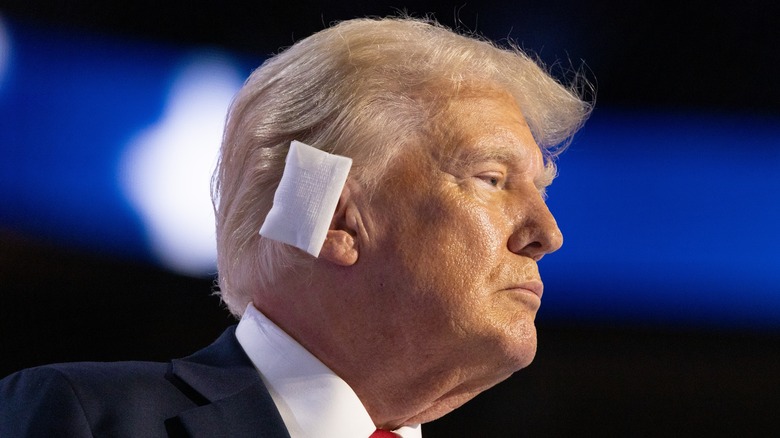3 Things We're Still Learning About The 2024 Assassination Attempt On Trump One Year Later
We may receive a commission on purchases made from links.
The 2024 U.S. presidential election was one of the wildest and most unpredictable in living memory. Both Donald Trump and Joe Biden's campaigns were rocked by major events that eventually swung the result in favor of the Republican presidential nominee. The former president and reality TV star had been out of the spotlight since losing the Oval Office to Biden in 2020. In fact, his political standing was seemingly damaged by the shocking events of January 6, 2021, a riot on Capitol Hill that critics claimed he had catalyzed.
Nevertheless, on November 15, 2022, Trump announced his intent to run again, and he seemed to have developed a major attack line against his Democratic opponent in portraying Biden as too old and in mental decline. This seemed to be confirmed during a presidential debate between the two that proved disastrous for Biden, who appeared confused and slow-witted. After some stalling, he was replaced on the ticket by his vice president, Kamala Harris.
The change saw momentum move away from Trump and toward the new Democratic nominee, who briefly seemed to capture the attention of the mainstream media in a way her opponent was struggling to do. But that all changed on July 13, 2024. At a campaign rally near Butler, Pennsylvania, a would-be assassin armed with a rifle took aim at Trump, wounding him and two others and killing a bystander, fire chief Corey Comperatore. The event was seismic for the campaign, and experts have since claimed it swung public opinion in Trump's favor. Nevertheless, details continue to emerge about the shocking event that never should have been allowed to happen.
New details of the assassin's background — and continued mysteries
The would-be assassin on that day was a 20-year-old named Thomas Crooks. He took aim at Donald Trump from a roof across from the stage on which the presidential candidate was addressing his supporters. Crooks fired a total of eight rounds before he was shot and killed by Secret Service agents on the scene.
Crooks was a graduate from a local community college, and investigations showed he was a dedicated student with aspirations to continue his education. However, it was also found that, while Crooks was mild-mannered, dedicated, and attentive to educators, in private, he was taking a darker turn. Having used his college email to order supplies online, Crooks was reportedly attempting to build his own bomb.
All the while Crooks' behavior in the run-up to the assassination attempt had grown increasingly erratic. He had seemingly attempted to self-diagnose his mental health, with his internet search history showing he was researching depression and other mental health disorders. In the days before the attack, he had frequently visited a nearby rifle range. On the day he left his parents' home with his firearm, this is where he said he was going.
Nevertheless, investigations have failed to uncover any definite motive for the attack. Crooks left no manifesto or confession, and there are no other suspects. Of course, conspiracy theories abound that Crooks was set up, and the real killer has yet to be revealed.
There have been Secret Service suspensions
Thomas Crooks was able to get himself into a position to take eight shots at a presidential nominee who was supposed to have 24-hour protection from the Secret Service. Unsurprisingly, the agency come under heavy criticism. Many deemed the agents on duty that day to have failed in their task to adequately protect the nominee by securing the roof and — with the tragic death of Corey Comperatore and the other injuries the assassin caused — the public at large.
Comperatore's widow, Helen Comperatore, has been especially vocal in her criticism of the agents that failed to adequately prevent the attack from taking place. "We were all sitting ducks that day," she told Fox News. "Our blood is all over their hands. I am angry. I lost the love of my life. They screwed up." On the Wednesday prior to the first anniversary of the attack, it was revealed that six Secret Service agents had been suspended without pay as an investigation into potential failings is ongoing. When the results of this investigation will be made public has not yet been revealed. In the meantime, many things continue not to make sense about both the attack and the Secret Security response.
Trump demanded a CT scan
Donald Trump himself received a wound to his right ear during the attack. Early statements from then-FBI Director Christopher Wray suggested that the injury could have been from shrapnel or another fragment thrown into the air by the shots. But the agency has since confirmed that all evidence points to the fact that a bullet did indeed graze the presidential nominee's ear. And despite nearly losing his life, Trump turned the horrifying incident into a political advantage with his reaction, which was to return to the podium and pump his fist at the audience, which was chanting "Fight! Fight! Fight!" It was a moment that resulted in the most iconic image of the campaign — a bloodied Trump with his fist aloft in apparent defiance.
Trump was taken to the hospital for check-ups shortly after the shooting, and even there, he reportedly continued to keep his mind on the campaign. According to "2024: How Trump Retook the White House and the Democrats Lost America," while there, the presidential nominee insisted on a CT scan of his brain, though doctors informed him that such a scan was unnecessary. Trump seemingly believed that the results of such a test would demonstrate healthy cognitive function — "It's like an IQ test," he reportedly said. "They tell you that your brain is good, so I just want to have that." He also later claimed that he was bleeding as if he had been shot four or five times, despite his only injury being to his ear.
If you or someone you know needs help with mental health, please contact the Crisis Text Line by texting HOME to 741741, call the National Alliance on Mental Illness helpline at 1-800-950-NAMI (6264), or visit the National Institute of Mental Health website.



